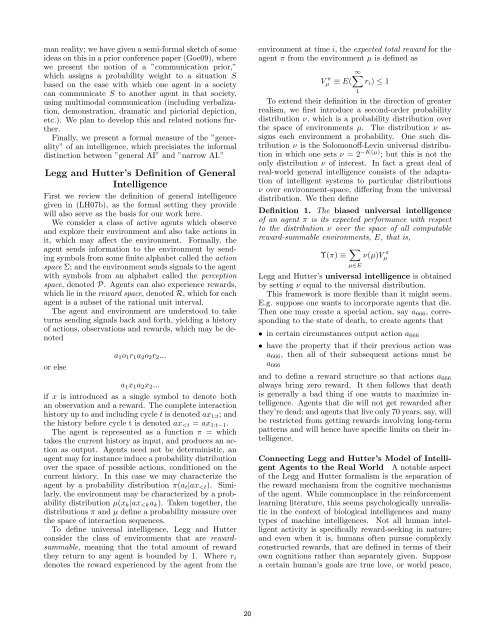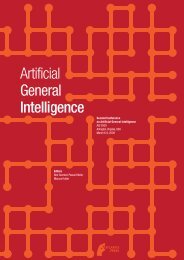Advances in Intelligent Systems Research - of Marcus Hutter
Advances in Intelligent Systems Research - of Marcus Hutter
Advances in Intelligent Systems Research - of Marcus Hutter
You also want an ePaper? Increase the reach of your titles
YUMPU automatically turns print PDFs into web optimized ePapers that Google loves.
man reality; we have given a semi-formal sketch <strong>of</strong> some<br />
ideas on this <strong>in</strong> a prior conference paper (Goe09), where<br />
we present the notion <strong>of</strong> a ”communication prior,”<br />
which assigns a probability weight to a situation S<br />
based on the ease with which one agent <strong>in</strong> a society<br />
can communicate S to another agent <strong>in</strong> that society,<br />
us<strong>in</strong>g multimodal communication (<strong>in</strong>clud<strong>in</strong>g verbalization,<br />
demonstration, dramatic and pictorial depiction,<br />
etc.). We plan to develop this and related notions further.<br />
F<strong>in</strong>ally, we present a formal measure <strong>of</strong> the ”generality”<br />
<strong>of</strong> an <strong>in</strong>telligence, which precisiates the <strong>in</strong>formal<br />
dist<strong>in</strong>ction between ”general AI” and ”narrow AI.”<br />
Legg and <strong>Hutter</strong>’s Def<strong>in</strong>ition <strong>of</strong> General<br />
Intelligence<br />
First we review the def<strong>in</strong>ition <strong>of</strong> general <strong>in</strong>telligence<br />
given <strong>in</strong> (LH07b), as the formal sett<strong>in</strong>g they provide<br />
will also serve as the basis for our work here.<br />
We consider a class <strong>of</strong> active agents which observe<br />
and explore their environment and also take actions <strong>in</strong><br />
it, which may affect the environment. Formally, the<br />
agent sends <strong>in</strong>formation to the environment by send<strong>in</strong>g<br />
symbols from some f<strong>in</strong>ite alphabet called the action<br />
space Σ; and the environment sends signals to the agent<br />
with symbols from an alphabet called the perception<br />
space, denoted P. Agents can also experience rewards,<br />
which lie <strong>in</strong> the reward space, denoted R, which for each<br />
agent is a subset <strong>of</strong> the rational unit <strong>in</strong>terval.<br />
The agent and environment are understood to take<br />
turns send<strong>in</strong>g signals back and forth, yield<strong>in</strong>g a history<br />
<strong>of</strong> actions, observations and rewards, which may be denoted<br />
or else<br />
a 1 o 1 r 1 a 2 o 2 r 2 ...<br />
a 1 x 1 a 2 x 2 ...<br />
if x is <strong>in</strong>troduced as a s<strong>in</strong>gle symbol to denote both<br />
an observation and a reward. The complete <strong>in</strong>teraction<br />
history up to and <strong>in</strong>clud<strong>in</strong>g cycle t is denoted ax 1:t ; and<br />
the history before cycle t is denoted ax













